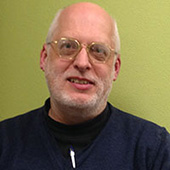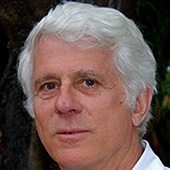Faculty and staff set the green bar high
Northwestern’s faculty and staff are setting great examples for students and peers by personally committing to lower their environmental footprint. From living in geothermal homes to participating in the first ever Earth Day, these NU community members are exemplifying what it means to live sustainably!
 Robert Carlton
Robert Carlton
Position: Facilities Management Design and Construction Project Manager
How you are committing to lowering your environmental footprint?
As an architect, my interests revolve around buildings, so I try to see that they are built and can be operated as efficiently as possible. I also love to fix things so they can be reused! For example, I enjoy taking things that need a simple repair and putting it back into service, and I have always bought and driven used cars. When my kids were young they used to break things just so I would fix them.
My family and I spent five years doing a complete frame-up renovation and restoration of my 1880 home. We installed a multi-unit, multi-zone geothermal mechanical system with automated energy recovery systems, used high-performance closed cell spray insulation to tighten the building envelope, and designed the building with air-lock vestibules. We also reused and thermally enhanced the original windows with period wooden storms and restored the original 1920 masonry and stucco finish, rather than tearing it off. All of the finishes were selected for period authenticity, low maintenance, and longevity. Though geothermal is far more expensive than a conventional system, I believe it is proves to be more efficient and cost-effective over time. A gas-fired furnace typically lasts for 25 years, but the geothermal infrastructure should have closer to a 75 year longevity.
What do you recommend the NU community do to lower their environmental footprint?
The three R’s: Reduce, Reuse, Recycle! Or, the architect’s 3 R’s: Renovate, Restore, Recycle! When shopping, look for products that are built for longevity, and restore them rather than replace them.
 Sarah Pritchard
Sarah Pritchard
Position: Dean of Libraries at Northwestern University, which means I oversee all of the various libraries on the Evanston and Chicago campuses, including Oak Grove Library Center in Waukegan and the Northwestern University Press. But I do not oversee the Law and Medicine libraries.
How you are committing to lowering your environmental footprint?
I have been committed to taking steps to protect the environment and reduce waster ever since the first Earth Day in 1970 – in which I participated as a high school student. I still have an original lapel button! This has meant doing all of the simple things like recycling paper, plastic, and cans, reusing and donating items, and having energy-efficient appliances. In the last few years, I have significantly increased the level of my personal engagement since now I’m married to an environmental scientist (Professor Neal Blair of CEE/EPS) who has a great commitment to making our entire household greener. So we have a compost bin in the backyard that generates soil for our garden, we use CFL and LED lights wherever we can, have programmable thermostats, do even more recycling (including batteries and old electronics), and most notably, we replaced one of our cars with an all-electric Nissan Leaf. That’s the form of transportation we use most days for routine commuting and errands. We have a charger in our garage; we recharge about once a week and barely even notice it on our electric bills. Since Evanston is now using alternative sources for electricity, it’s even more beneficial. We’ve also been looking into whether we can install solar panels to power some of our household electrical needs.
What do you recommend the NU community do to lower their environmental footprint?
Start with all the easy things, like walking or taking public transportation when you can, recycling *everything* that’s in a category for pick-up by the city, and saving and reusing things like packing boxes and freebie memo pads that come in the mail. I can’t remember the last time I purchased lunch bags; there are so many equivalents that you get from your own shopping and gifts. Purchase “green” and recycled products for everyday needs. Then, depending on your family size and where you live, you can think about gradually adding bigger things as they become more widely available and easy to use: compost bins and rain barrels, for example, work even in quite small yards and are a lot less trouble than people think. We were watching the electric car market for several years before models finally came into production that were practical for daily driving and available in this area. You also can get lots of good ideas at various local “green living festivals” and at events sponsored by the Solid Waste Agency of Northern Cook County (SWANCC). SWANCC has a huge website listing events and how to recycle all sorts of products.
 Bill Revelle
Bill Revelle
Position: Judd A. and Marjorie Weinberg College of Arts and Sciences Professor of Psychology and Director of the Personality Program
How are you committing to lowering your environmental footprint?
Reducing one's environmental footprint is a never-ending task. It requires constant monitoring, and reduction when possible, of energy usage. Things as simple as walking or biking rather than driving, changing light bulbs to more efficient types, and reducing the amount of energy used to heat one's home all make a difference.
In 2001 my wife and I were fortunate enough to be able to build a new house in Evanston. Having been brought up discussing carbon dioxide (CO2) and the problem of global climate change at the dinner table, it was obvious that we would try to build as sustainable house as feasible given the technology then available. Searching the web for ideas, we were able to build a house that produces much less CO2 than our previous house. Following Energy Star Guidelines, we installed triple-glazed windows, R38 attic insulation, R19 batt insulation in the walls using 2 x 6" framing, and an energy recovery ventilation system. Because water use is a major source of energy demand (at the municipal level where it needs to be filtered and then subsequently purified), we also installed dual-flush low-flow toilets, an underground cistern to collect rainwater, and permeable and grassy pavers in the driveway to reduce runoff.
By installing photovoltaic arrays to generate power and solar-thermal collectors to heat our water and help heat the house, by buying Energy Star appliances, and by monitoring our total electrical and gas usage, we are now able to produce roughly 75 percent of our electricity on a year round basis and use about 50 percent of the gas that a house of our size would otherwise use. (In the summer, we produce about 150 percent of our energy demands and sell the excess to the grid; in the winter, our electrical usage increases and our PV production decreases and we produce about 20 percent of our demands.) If we were to do this again, we would be able to take advantage of the great increase in efficiency of solar PV cells, and we would use even higher levels of insulation.
What do you recommend the NU community do to lower their environmental footprint?
It is not necessary to build a house to reap many of the energy savings that are possible. Walking rather than driving, taking the bus or the train rather than using a car, using an electric or hybrid car rather than a conventional car all make a difference. Retrofitting your home by improving the insulation in the attic will make for a warmer and more efficient house. Citizens' Greener Evanston is working to reduce Evanston's carbon footprint by 20 percent by 2016 in many different ways. Visiting their website will provide information on how to get 50 percent rebates on the cost of improving the energy efficiency of your home. In addition, many academics fly a great deal and thus add .5 tons to their carbon footprint for every 1,000 miles they fly. Although we cannot replace all of this travel with video conferences, we can partly compensate for our carbon production by helping others reduce their carbon emissions. One way to do this is to contribute to the Evanston Community Foundation's Climate Action Fund to support emissions-reduction projects here in Evanston.
 Mark Witte
Mark Witte
Position: Director of Undergraduate Studies in Economics
How you are committing to lowering your environmental footprint?
I try to avoid getting in cars and watch what I eat to minimize my impact.
What do you recommend the NU community do to lower their environmental footprint?
Bike, take shorter showers, be vegetarian, and read a lot on the topic.